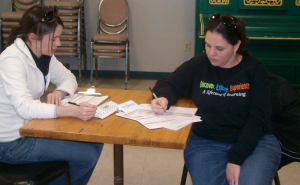By Mark Hansel
NKyTribune Contributor
The annual Kentucky Housing Corporation’s K-Count to identify the state’s homeless population took place throughout the Commonwealth last week.
The K-Count, formerly identified as the Point-in-Time Homeless Count, is used to help determine how much federal funding will be awarded for homeless programs from the U.S. Department of Housing and Urban development (HUD). It also help local agencies determine where and how to provide assistance.
Laura Pleiman, Boone County Human Services Director, said HUD requires the count every other year, but Kentucky conducts it annually.
“In Kentucky, we choose the last Wednesday of January, usually one of the coldest days of the year, to make sure most folks are in shelters, because that makes the count a little easier,” Pleiman said. “It’s so important because it does affect how much funding comes to the area. In Boone County we need to get out and find folks because we don’t have a shelter and we want to make sure that funds are there to help provide services for those individuals.”
While the county has a few urban areas, it does not have the centralized points of congregation for the homeless that exist in Covington or Newport.
The geographic nature of Boone County presents real challenges to obtaining an accurate count.
“Folks who are homeless here might be living in the woods and are harder to find,” Pleiman said. “And it’s cold, so if people are outside and hunkered down, they don’t necessarily want to come out to participate.”
The HUD definition of a homeless person can also have an impact on obtaining an accurate count. Persons staying in a motel, for example, do not meet the HUD definition of homeless.

Volunteers Ashley Dragan, a junior at Cooper High School, and Mary Neal of the Boone County Extension Homemakers, help hand out food items
During last year’s extreme cold, some Northern Kentucky organizations paid for hotels for members of the area’s homeless population during the week of the count, so they could not be included. Families without a permanent residence are sometimes housed in pay-by-the-week hotels or motels and also do not meet the HUD definition for homelessness.
The Florence Branch of the Boone County Public Library was the base of activity for this year’s count.
Melanie Sperling, Outreach Manager at Boone County Public Library, said that in years past, the count was based at the Florence Christian Church.
“Since the library is one of the few public places where the homeless are known to seek daytime shelter in the county, it just made sense to have it there,” Sperling said. “We had some breakfast items that were donated by the Boone County Extension Homemakers and we really are trying to cater to the homeless this year.”
The library also expanded the effort to include some much-needed assistance to other needy families in the county.
The Freestore Foodbank Mobile Pantry was on hand to provide food items for 100 families.
The Extension Homemakers and library workers donated new packages of socks and underwear, as well as new and gently used outerwear. The Boone County Youth Cabinet also collected more than 1,000 personal hygiene items that were distributed at the library Wednesday.
Ashley Dragan, 16, was one of about 20 volunteers from the Youth Cabinet that helped hand out food items. Dragan, a junior at Cooper High School, said the community-service project was a great opportunity to give back to the community.
“I didn’t realize how many people in our community really need stuff like this,” Dragan said. “It really opened my eyes.”
Results of the local K-Count, as well as statewide numbers, will be available in a few weeks. Last year, the Kentucky Housing Cabinet, also conducted a summer count and hopes to make that an annual event as well.



















